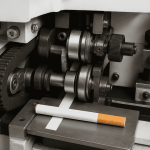Introduction
The tobacco industry is undergoing a technological revolution that is reshaping the manufacturing of cigarettes. With the advent of new machinery and innovations, cigarette production is becoming more efficient, automated, and sustainable. From automation systems to advanced quality control measures, the integration of modern technology into cigarette machinery is helping manufacturers meet growing demand while minimizing costs and improving product consistency. In this article, we will explore the key advancements in cigarette machinery, focusing on efficiency, automation, and innovation, and how these technologies are driving the future of the tobacco industry.
The Rise of Automation in Cigarette Manufacturing
Automation in production processes has become a driving force in the cigarette industry, significantly enhancing the speed and consistency of manufacturing. Automation systems are designed to perform repetitive tasks such as blending, packaging, and sorting, reducing the reliance on manual labor and lowering production costs.
Automated Blending Systems: Automated blending systems are designed to mix different types of tobacco efficiently and consistently. These machines use sophisticated sensors and computer-controlled systems to ensure that the right blend is produced every time, resulting in a more uniform final product. Automation in the blending process has not only reduced human error but also increased throughput, enabling manufacturers to meet the high demands of the market.
High-Speed Cigarette Rolling Machines: High-speed cigarette rolling machines are capable of producing thousands of cigarettes per minute, revolutionizing the speed and efficiency of production lines. These machines are equipped with advanced sensors that detect and correct errors in real-time, minimizing waste and improving product quality. The integration of high-speed machines has allowed manufacturers to increase their production capacity while maintaining product consistency.
Robotic Packaging Solutions: Automation extends to the packaging process as well, where robotic systems are increasingly used to pack and label cigarettes. These robots are programmed to handle various packaging tasks, including inserting cigarettes into boxes, wrapping them, and labeling the packages. The use of robotics has reduced the time and labor involved in packaging, improved accuracy, and reduced the potential for contamination.
Efficiency Gains through Technological Advancements
Technological advancements in cigarette machinery have brought about significant improvements in efficiency. These improvements have allowed manufacturers to lower production costs, increase output, and improve sustainability in the industry.
Energy-Efficient Machinery: As global awareness of environmental concerns rises, manufacturers are increasingly adopting energy-efficient machinery to reduce their carbon footprint. Newer machines are designed to consume less power while maintaining or even increasing production rates. Energy-efficient equipment helps manufacturers reduce operational costs and meet sustainability goals, contributing to a greener industry.
Material Optimization and Waste Reduction: With the integration of smart technologies, cigarette machines now have the ability to optimize material usage, reducing waste and minimizing the cost of raw materials. For example, advanced sensors can detect slight variations in the tobacco blend, allowing the machine to make real-time adjustments to ensure the right amount of material is used. This leads to significant cost savings and reduces the environmental impact associated with production waste.
Predictive Maintenance: Predictive maintenance has emerged as a game-changing technology in cigarette manufacturing. By using sensors and data analytics, manufacturers can predict when a machine is likely to experience a failure or breakdown. This allows for proactive maintenance, which helps avoid costly downtime and extends the lifespan of the machinery. Predictive maintenance ensures that machines operate at peak efficiency, minimizing disruptions to the production process.
Innovation in Cigarette Machinery
Innovation is at the heart of the technological revolution in cigarette machinery. Manufacturers are constantly pushing the boundaries of what is possible to create more efficient, user-friendly, and high-performance machines.
Smart Cigarette Machines: The introduction of smart cigarette machines is one of the most exciting innovations in the tobacco industry. These machines are equipped with sensors, cameras, and artificial intelligence (AI) to monitor and optimize the production process in real-time. Smart machines can adjust settings automatically based on production data, ensuring that the cigarettes meet quality standards without requiring manual intervention. This level of automation not only improves efficiency but also enhances the quality of the product.
Integration of Artificial Intelligence (AI): Artificial intelligence is revolutionizing the cigarette manufacturing process by enabling machines to learn from data and make decisions based on that information. AI algorithms can predict demand trends, optimize machine settings for efficiency, and even improve the quality of the tobacco blend. This level of intelligence helps manufacturers stay ahead of market trends and deliver high-quality products consistently.
Advanced Quality Control Systems: Advanced quality control systems are now integrated into cigarette machinery, ensuring that each cigarette produced meets the highest standards of quality. These systems use technologies such as machine vision, AI, and sensor-based feedback to identify defects in real-time and adjust production parameters accordingly. Whether it’s detecting tobacco defects, monitoring cigarette length, or ensuring uniformity in packaging, these systems have revolutionized quality assurance in the tobacco industry.
Sustainable and Eco-Friendly Innovations: As the demand for sustainability grows, manufacturers are focusing on creating machines that minimize waste and energy consumption. New technologies, such as biodegradable packaging and eco-friendly filtration systems, are helping to reduce the environmental impact of cigarette production. Additionally, some manufacturers are exploring alternative tobacco products, such as smokeless cigarettes and e-cigarettes, using innovative machinery designed specifically for these new products.
The Future of Cigarette Manufacturing
The technological revolution in cigarette machinery is far from over. As new advancements continue to emerge, the industry is likely to see even greater changes in the coming years. Here are a few key trends that will shape the future of cigarette manufacturing:
Industry 4.0 and IoT Integration: The integration of the Internet of Things (IoT) into cigarette manufacturing will allow machines to communicate with each other, share data, and make autonomous decisions. This will enable manufacturers to create highly efficient, self-optimizing production lines that require minimal human intervention.
Customization and Personalization: As consumer demand for personalized products increases, there is potential for the cigarette industry to adopt customization in the production process. With advancements in machinery, manufacturers could offer personalized blends, packaging, and even designs, catering to niche markets and offering a unique consumer experience.
Next-Generation Automation: The next generation of automation will likely involve even more sophisticated systems capable of handling more complex tasks and offering higher levels of flexibility. With the rise of collaborative robots (cobots), manufacturers will be able to achieve more customized production runs and operate with greater agility.
Sustainability as a Key Driver: Future innovations in cigarette machinery will likely place a stronger emphasis on sustainability. This could involve the development of machines that utilize renewable energy sources, advanced recycling technologies, and even innovations in biodegradable cigarette production.
Conclusion
The technological revolution in cigarette machinery is transforming the way cigarettes are produced. Through automation, efficiency gains, and innovation, the industry is becoming more competitive, sustainable, and capable of meeting consumer demands. As new technologies continue to emerge, the future of cigarette manufacturing looks increasingly high-tech, efficient, and eco-friendly. Manufacturers who embrace these changes and invest in cutting-edge machinery will be well-positioned to thrive in the rapidly evolving market.
As the industry evolves, one thing is certain: technology will continue to play a critical role in driving the future of cigarette production. From automation systems to smart machinery and AI-powered solutions, the advancements in cigarette machinery are paving the way for a more efficient, sustainable, and innovative tobacco industry.





